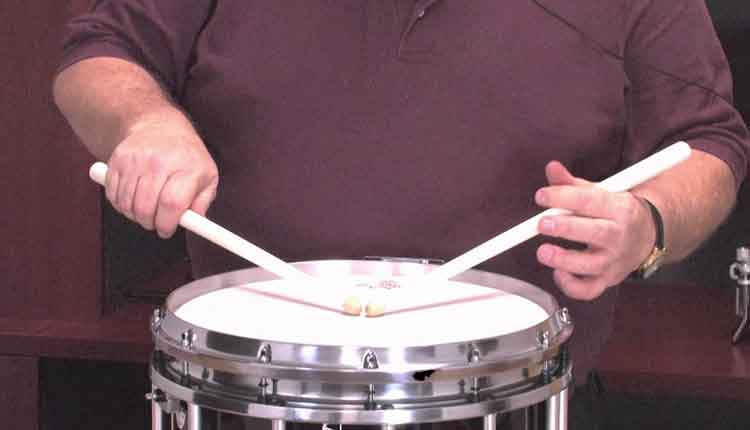There is nothing more important for the beginning percussionist than to establish the correct snare drum grip. Just like the wind player with an improper embouchure, the percussionist with an improper grip will continually be hampered in everything else he may try to learn and develop. Understandably, many non-percussionist band directors feel insecure when it comes to this essential aspect of percussion playing. I would like to offer some practical tips to help in this vital area.
Matched Grip verses Traditional Grip
The matched grip (holding both sticks the same way) is preferable to the traditional grip for several reasons. First, it is much easier to learn. Students almost never learn the left-hand traditional grip correctly. Secondly, the matched grip is a universal grip which, with very little modification, can be used to play marimba, xylophone, orchestra bells, timpani, drum set, in addition to snare drum. The traditional grip was developed centuries ago for use on a slanted marching drum. Now, with flat carriers, the matched grip can even be used for marching. However, many still choose to use traditional for its visual appeal. But I don’t believe this is a sufficient reason to teach traditional grip, especially when students who choose to play the other instruments in the percussion family will eventually have to learn matched grip anyway.
Teaching the Matched Grip
- Have the student completely relax their hands. Point out that the fingers are slightly curved and that the thumb falls against the first joint of the index finger and not against the side of the hand.
- Place the drumstick into the hand so as to maintain the hand’s natural position. Maintain the gap between the thumb and the side of the hand.
- Explain that a fulcrum is created between the thumb and the first joint of the index and middle fingers; a “three point grip”. This is extremely important. Do not allow the stick to slide up into the second joint of the index finger. This will close the natural gap between the thumb and the side of the hand and produce tension. The stick should pivot between the fleshy part of the thumb and the first joints of the index and middle fingers.
- The wrist must work in a waving motion that makes it necessary for the hands to be held palms down with the top of the hand flat.
- The grip should be relatively loose and the back two fingers should not be clamped down on the stick. (We call this the “death grip”) The stick should be free to bounce up from the drum, pivoting on the fulcrum created by the thumb, index and middle fingers.
Tom Morgan has been Director of Percussion Studies at Washburn University in Topeka, Kansas, where he teaches applied percussion and directs the Washburn University Percussion Ensemble. He holds Bachelors and Masters degrees in music education and music theory and composition from the University of Northern Colorado and a Doctoral degree in percussion performance from the University of Oklahoma. Along with his teaching duties at Washburn, Dr. Morgan has a large private studio made up of elementary, junior high and high school percussion students from the surrounding community. He is the author of A Sequential Approach to Fundamental Snare Drum, and A Sequential Approach to Rudimental Snare Drum, snare drum instruction methods, and The Drumset Reading Workbook, all published by C. Alan Publications.
As a performer, Dr. Morgan is very active in the Topeka and Kansas City areas, performing and recording with numerous groups, including the Trilogy Big Band, a seventeen-piece jazz ensemble with two recently released CDs on the Sea Breeze Jazz recording label. He has also recorded with the Boulevard Big Band and performs with them at Harlings in Kansas City. In addition, Tom has performed with the Topeka Symphony Orchestra, the Kansas City Symphony Orchestra, and the Topeka Jazz Workshop big band. He is a regional endorser for Pro-Mark drumsticks, Encore Mallets and performs regularly on Tree House Drums, which are hand made in Topeka, Kansas. He is in demand as a clinician at festivals and music camps throughout the region.
This Article Sponsored by Pro-Mark


